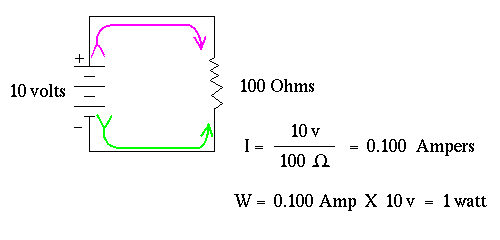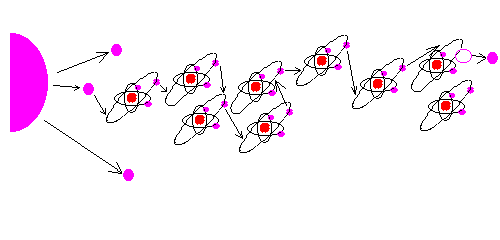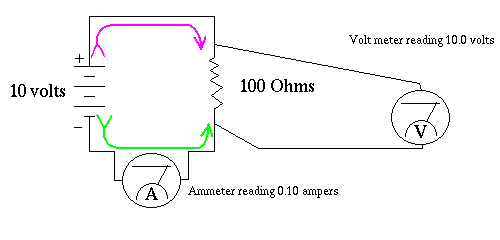


Current Flow is the name given to what primitive scientists imagined was electric fluid flowing through a wire. They later discovered that "free electrons" were infact, what was moving, and that, much to their, and everybody else's chagrin, the electrons flow in the opposite direction than first believed...
As it turns out both current flow, and electron flow, are equally valid
in a practical sense, until you get to the point where you are trying to
understand things like vacuum tubes, solid state physics, or
electro-chemistry, where you are actually trying to deal with electrons.
In the top pictorial, I show the simplest of circuits. Electricity
flows from one end of the battery, through the resistor, and back to the
other end of the battery. If you're a "current flow man" (sorry ladies
but I have never heard that vernacular used in the female context, and to
do so here I feel would be demeaning of the female gender), any way if
you're a "current flow man" the blue arrow at the top, depicts the current
flowing from the (+) positive terminal of the battery, through the resistor
and ultimately completing the circuit as in enters the negative end of the
battery. If on the other hand you're an "electron flow man" to you the
world is upside down, electrons flow from the (-) negative end of the
battery, back up through the resistor, and back into the positive end of
the battery. Both notions are equally valid. Select one, as your primary
method of conceptualizing a circuit, and fall back on the other, for deeper
understanding.
At the risk of alienating many authors of text books on this subject,
Electrons do not really flow through wires. What happens is, a charge
disturbance, such as an electric field, AKA "a potential difference" enters
a conductor at one end, applying electrons to the loosely bound electrons in
orbitals of atoms that make up the conductor, by providing "Extra" electrons
some of these find their way into a weakly bound orbital. The extra charge
they carry, makes the atoms orbital unstable, and so it gives up it's own
electron, part of the time. That electron does the same to another atoms,
whose location in the conductor, is less likely to compete with the general
charge entering from the end causing the disturbance in charge
Incidentally the difference between a conductor, and a non conductor, is the
lack, of any loosely bound electrons. In a non conductor, an "insulator" all
of the electrons are tightly held in place, by stable charge pairing.
Resistors, and semiconductors live in a grey area, between having really
easily dislodge-able electrons, and tightly held electrons.
A first order approximation of a wire, is that all points along
the length of the wire are a single point, an Ammeter tries real hard to
be a wire, that is, if it is a good Ammeter, it is a good approximation
of a wire. To be a good approximation of a wire, it needs to offer as
little electrical resistance as possible. The reality of this is that
in order for current to move the pointer needle across the scale, some
electrical energy must be extracted from the system. Therefore a real
Ammeter has, unfortunately, some electrical resistance. A Volt Meter on
the other hand, if it is a good Volt Meter, should be an open circuit,
that is, it should be of infinite resistance, however the reality of
energy being required to push the pointer indicator needle across the
scale, makes this lofty goal impossible. Real Volt Meters have less
than infinite resistance, they infact do draw some, small amount of
current.
Back to Learn Electronics Next